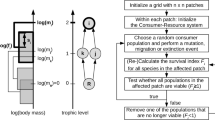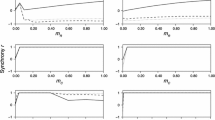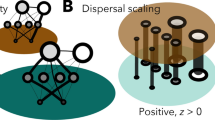Abstract
Population density can be affected by its prey [resource] and predator [consumer] abundances through two different mechanisms: the alternation of birth [or somatic growth] or death rate and inter-habitat movement. While the food-web theory has traditionally been built on the former mechanism, the latter mechanism has formed the basis of a successful theory explaining the spatial distribution of organisms in the context of behavioral and evolutionary ecology. Yet, few studies have compared these two mechanisms, leaving the question of how similar (or different) predictions derived from birth–death-based and movement-based food-web theories unanswered. Here, theoretical models of the tri-trophic (resource–consumer-top predator) food chain were used to compare food-web patterns arising from these two mechanisms. Specifically, we evaluated the response of the food-chain structure to inter-patch differences in productivity for movement-based models and birth–death-based models. Model analysis reveals that adaptive movements give rise to positively correlated responses of all trophic levels to increased productivity; however, this pattern was not observed in the corresponding birth–death-based model. The movement-based model predicts that the food chain response to productivity is determined by the sensitivity of animal movement to the environmental conditions. More specifically, increasing sensitivity of a consumer or top predator leads to smaller inter-patch variance of the resource or consumer density, while increasing inter-patch variance in the consumer or resource density. In conclusion, adaptive movement provides an alternative mechanism correlating the food-web structure to environmental conditions.



Similar content being viewed by others
References
Abrams PA (1993) Effects of increased productivity on the abundances of trophic levels. Am Nat 141:351–371
Abrams P (1995) Monotonic or unimodal diversity-productivity gradients: what does competition theory predict? Ecology 76:2019–2027
Abrams PA (2007) Habitat choice in predator–prey systems: spatial instability due to interacting adaptive movements. Am Nat 169:581–594
Abrams PA, Roth J (1994) The responses of unstable food chains to enrichment. Evol Ecol 8:150–171
Adler PB, Raff DA, Lauenroth WK (2001) The effect of grazing on the spatial heterogeneity of vegetation. Oecologia 128:465–479
Allesina S, Tang S (2012) Stability criteria for complex ecosystems. Nature 483:205–208
Alonzo SH (2002) State-dependent habitat selection games between predators and prey: the importance of behavioural interactions and expected lifetime reproductive success. Evol Ecol Res 4:759–778
Arditi R, Ginzburg LR (1989) Coupling in predator–prey dynamics: ratio-dependence. J Theor Biol 139:311–326
Bastolla U, Fortuna MA, Pascual-García A, Ferrera A, Luque B, Bascompte J (2009) The architecture of mutualistic networks minimizes competition and increases biodiversity. Nature 458:1018–1020
Bolker B, Holyoak M, Krivan V, Rowe L, Schmitz O (2003) Connecting theoretical and empirical studies of trait-mediated interactions. Ecology 84:1101–1114
Briggs CJ, Hoopes MF (2004) Stabilizing effects in spatial parasitoid–host and predator–prey models: a review. Theor Popul Biol 65:299–315
Cowie RJ, Krebs JR (1979) Optimal foraging in patchy environments. In: Anderson RM, Turner BD, Taylor RL (eds) Population dynamics. Blackwell Scientific Publications, Oxford, pp 183–205
Cressman R, Garay J (2009) A predator–prey refuge system: evolutionary stability in ecological systems. Theor Popul Biol 76:248–257
Cressman R, Křivan V, Garay J (2008) Ideal free distributions, evolutionary games, and population dynamics in multiple- species environments. Am Nat 164:473–489
DeAngelis DL, Persson L, Rosemond AD (1995) Interaction of productivity and consumption. In: Polis G, Winemiller KO (eds) Food Webs. Kluwer, Dordrecht, pp 109–112
deRuiter P, Wolters V and Moore J (2005) Dynamic food webs. Elsevier, Burlington
Fretwell SD, Lucas HL (1969) On territorial behavior and other factors influencing habitat distribution in birds. Acta Biotheor 19:16–36
Fretwell SD (1972) Populations in a seasonal environment. Princeton University Press, Princeton
Hairstone NG, Smith FE and Slobodkin LB (1960) Community structure, population control, and competition. Am Nat 94:421–425
Holt RD (1984) Spatial heterogeneity, indirect interactions, and the coexistence of prey species. Am Nat 124:377–406
Holt RD (1985) Population dynamics in two-patch environments: some anomalous consequences of an optimal habitat distribution. Theor Popul Biol 28:181–208
Holt RD (1996) Food webs in space: an island biogeographic perspective. In: Polis G, Winemiller KO (eds) Food Webs. Kluwer, Dordrecht, pp 313–323
Hugie DM, Dill LM (1994) Fish and game: a game theoretic approach to habitat selection by predators and prey. J Fish Biol 45(Supplement sA):151–169
Iwasa Y (1982) Vertical migration of zooplankton: a game between predator and prey. Am Nat 120:171–180
Jackson AL, Ranta E, Lundberg P, Kaitala V, Ruxton GD (2004) Consumer-resource matching in a food chain when both predators and prey are free to move. Oikos 106:445–450
Johnson AR, Wiens JA, Milne BT, Crist TO (1992) Animal movements and population dynamics in heterogeneous landscapes. Landsc Ecol 7:63–75
Kacelnik A, Krebs JR, Bernstein C (1992) The ideal free distribution and predator–prey populations. Trends Ecol Evol 7:50–55
Kagata H, Ohgushi T (2006) Bottom-up trophic cascades and material transfer in terrestrial food webs. Eco Res 21:26–34
Křivan V (1997) Dynamic ideal free distribution: effects of optimal patch choice on predator–prey dynamics. Am Nat 149:164–178
Křivan V, Cressman R (2009) On evolutionary stability in predator–prey models with fast behavioural dynamics. Evol Ecol Res 11:227–251
Křivan V, Cressman R, Schneider C (2008) The ideal free distribution: a review and synthesis of the game-theoretic perspective. Theor Popul Biol 73:403–425
Lima SL, Dill LM (1990) Behavioral decisions made under the risk of predation: a review and prospectus. Can J Zool 68:619–640
Lima SL (2002) Putting predators back into behavioral predator–prey interactions. Trends Ecol Evol 17:70–75
Lotka AJ (1925) Elements of physical biology. Williams and Wilkins Company, Baltimore
McCann KS, Rasmussen JB, Umbanhowar J (2005) The dynamics of spatially coupled food webs. Ecol Lett 8:513–523
McCann KS, Rooney N (2009) The more food webs change, the more they stay the same. Philos Trans R Soc B Bio Sci 364:1789–1801
Mittelbach GG, Osenberg CW, Leibold MA (1988) Trophic relations and ontogenetic niche shifts in aquatic ecosystems. In: Ebenman B, Persson L (eds) Size-structured populations. Springer, Berlin, pp 219–235
Morales JM, Moorcroft PR, Matthiopoulos J, Frair JL, Kie JG, Powell RA, Merrill EH, Haydon DT (2010) Building the bridge between animal movement and population dynamics. Philos Trans R Soc B 365:2289–2301
Mougi A, Kondoh M (2012) Diversity of interaction types and ecological community stability. Science 337:349–351
Mougi A, Kondoh M (2014) Stabilizing effect of competition-antagonism-mutualism hybrid community and the role of community network structure. J Theor Biol 360:54–58
Oksanen L, Fretwell SD, Arruda J, Niemelä P (1981) Exploitation ecosystems in gradients of primary productivity. Am Nat 118:240–261
Oksanen L (1990a) Exploitation ecosystems in seasonal environment. Oikos 57:14–24
Oksanen T (1990b) Exploitation ecosystems in heterogeneous habitat complexes. Evol Ecol 4:220–234
Persson L, Bengtsson J, Menge BA, Power ME (1996) Productivity and consumer regulation - concepts, patterns, and mechanisms. In: Polis G, Winemiller KO (eds) Food Webs. Kluwer, Dordrecht, p 396–434
Polis G, Winemiller KO (1995) Food webs. Kluwer, Dordrecht
Power M (1992) Top-down and bottom-up forces in food webs: do plants have primacy? Ecology 73:733–746
Rosenzweig ML (1971) Paradox of enrichment: destabilization of exploitation ecosystems in ecological time. Science 171:385–387
Schmitz OJ, Hambäck PA, Beckerman AP (2000) Trophic cascades in terrestrial systems: a review of the effects of carnivore removals on plants. Am Nat 155:141–153
Sih A (1984) The behavioral response race between predator and prey. Am Nat 123:143–150
Strong DR (1992) Are trophic cascades all wet? Differentiation and donor-control in speciose ecosystems. Ecology 73:747–754
Thébault E, Fontaine C (2010) Stability of ecological communities and the architecture of mutualistic and trophic networks. Science 329:853–856
van Baalen M, Sabelis MW (1999) Nonequilibrium population dynamics of “ideal and free” prey and predators. Am Nat 154:69–88
Volterra V (1926) Variazioni e fluttuazioni del numero d’individui in specie animali conviventi. Mem R Accad Naz dei Lincei 2:31–113
Wang W, Takeuchi Y (2009) Adaptation of prey and predators between patches. J Theor Biol 258:603–613
Yodzis P (1984) Energy flow and the vertical structure of real ecosystems. Oecologia 65:86–88
Yodzis P, Innes S (1992) Body size and consumer-resource dynamics. Am Nat 139:1151–1175
Acknowledgments
This study was supported by the Research Fellowship 2014 of Ryukoku University, the Environment Research and Technology Development Fund (D-1102) of the Ministry of the Environment, Japan (MK), a Grant-in-Aid for Challenging Exploratory Research (no. 24657020; MK), a Grant-in-Aid for Young Scientists (B) (no. 25840164; AM) and a Grant-in-Aid for Scientific Research (C) (no. 23570024; AU) of the Japan Society for the Promotion of Science.
Author information
Authors and Affiliations
Corresponding author
Appendix
Appendix
I. Equilibrium state for the model with the birth–death process
-
(a)
Two-species model
The equilibrium is obtained by setting the right hand sides of Eq. 1a and b to zero and T to 0:
These equations are solved to give:
-
(b)
Three-species model
Similarly, the equilibrium for three-species is obtained by solving:
as:
Note, this system is always locally stable. Under equilibrium conditions, we obtain the Jacobian matrix, as follows:
The characteristic equation, the solution of which is the eigenvalue, is given as:
where:
The equilibrium point is locally stable if w 1, w 3 > 0 and w 1 w 2 > w 3, according to the Routh-Hurwitz criteria. It is trivial that w 1 > 0 because all parameter values are positive. Inequality w 3 > 0 always holds, as long as the consumer has a positive equilibrium density. Hence, the stability condition reduces to w 1 w 2 > w 3. We find the last condition reduces to rα > 0, which always holds.
II. Equilibrium state for the model with adaptive or non-adaptive movement
-
(a)
Two-species model with non-adaptive consumer
The equilibrium is obtained by solving:
as:
-
(b)
Two-species model with an adaptive consumer
The following equations should hold at equilibrium:
The two equations taken together give:
Note, when d(C 1 + C 2)/dt = 0, it holds that C 1 + C 2 = C total, where C total is constant. Thus, Eq. A8 becomes:
The LHS of Eq. A12 is a monotonically decreasing function of C 1 * with its limits:
and
The RHS of Eq. A12 is a monotonically increasing function of C 1 * with its limits:
and
Taken together, there should be unique \( {\overline{C}}_1^{\ast } \), which holds Eq. A12.
\( \overline{C_1^{\ast }} \) should also be larger than C const/2 as follows. The LHS of Eq. A12 is 1 for C i * = C const/2, while the RHS is smaller than 1 for C 1 * = C const/2 as:
suggesting that LHS should be larger than RHS for C 1 * = C const/2. Given that the LHS and LHS of Eq. A12 are decreasing and increasing functions of C 1 *, respectively, the solution, \( \overline{C_1^{\ast }} \), should be larger than C const/2. Thus, it follows that C 2 * > C 1 * as:
Note, when \( \left({C}_{\mathrm{const}}/\overline{C_1^{\ast }}\right)-1<1 \), it should follow that:
suggesting that r 2/C ∗2 − r 1/C ∗1 < 0 and, thus, R ∗1 > R ∗2 .
-
(c)
Three-species model with a non-adaptive consumer and non-adaptive top predator
The following equations should hold at equilibrium:
These three equations taken together give:
It should hold that R 1 * > R 2 * as r 1 > r 2 .
-
(d)
Three-species model with a non-adaptive consumer and adaptive top predator
The following equations should hold at equilibrium:
Further, note, when \( {f}_T=\frac{1}{1+{e}^{\theta_T\left(\beta C-\beta C\right)}}=0.5 \), it follows that:
It should hold that R 1 * > R 2 * as r 1 > r 2 .
-
(e)
Three-species model with an adaptive consumer and non-adaptive top predator
The following equations should hold at equilibrium:
Equation A17c gives:
Using this equation with Eq. A17b, we get:
Given this, Eqs. A17a and A17b are identical to A10a and A10b. Thus, R *1 > R *2 and C *1 > C *2 .
-
(f)
Three-species model with an adaptive consumer and adaptive top predator
At equilibrium, it should hold that:
Using Eq. A13a, Eqs. A13b and A13c are transformed to:
respectively. Note, when d(C 1 + C 2)/dt = 0 and d(T 1 + T 2)/dt = 0, it should hold that C 1 + C 2 = C const and that T 1 + T 2 = T const, where C const and T const are constants. Using these equations, Eqs. A13c and A14a taken together give:
LHS of Eq. A14b is a decreasing function of C 1 * with its limits, ∞ (C ∗1 → 0) and 0(C ∗1 → C const); RHS of Eq. A14b is an increasing function of C 1 * with its limits, 0(C ∗1 → 0) and ∞ (C ∗1 → C const). Therefore, there should exist a unique solution, C ∗1 , for Eq. A14b.
It should generally hold that T *1 > T *2 and, consequently, it should also hold that C *1 > C *2 and that R *1 > R *2 (r 1/C *1 > r 2/C *2 ). This is proved as follows. First, assume that T *1 < T *2 . Then, using Eq. A14b, it should follow that C *1 < C *2 . However, if both T *1 < T *2 and C *1 < C *2 hold, then Eq. A14a never holds, suggesting that it should not hold that T *1 < T *2 . Next, assume that T *1 = T *2 . Then, using Eq. A14b, it should follow that C *1 = C *2 . However, if both T *1 = T *2 and C *1 = C *2 hold, then Eq. A14a should never hold, suggesting that it should not hold that T *1 = T *2 . Consequently, it is proven that R *1 > R *2 , C *1 > C *2 and T *1 > T *2 always hold.
Rights and permissions
About this article
Cite this article
Kondoh, M., Mougi, A., Ushimaru, A. et al. Adaptive movement and food-chain dynamics: towards food-web theory without birth–death processes. Theor Ecol 9, 15–25 (2016). https://doi.org/10.1007/s12080-015-0266-8
Received:
Accepted:
Published:
Issue Date:
DOI: https://doi.org/10.1007/s12080-015-0266-8




